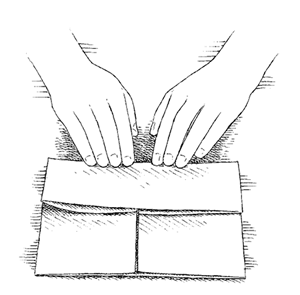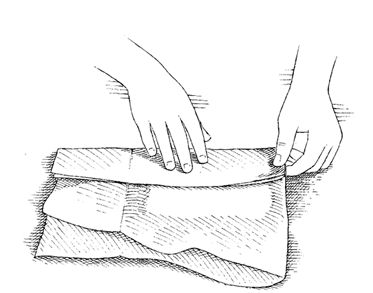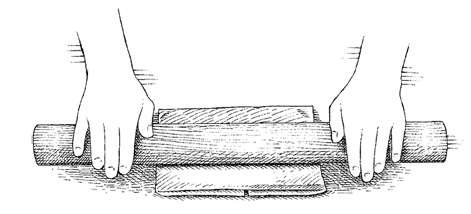The Cook's Illustrated Cookbook (358 page)
Read The Cook's Illustrated Cookbook Online
Authors: The Editors at America's Test Kitchen
Tags: #Cooking

MAKES 22
These croissants take at least 10 hours to make from start to finish, but the process can be spread over 2 days. European-style cultured butters have a higher butterfat content, which makes it easier to fold them into the dough. (Our favorite is from Plugrá.) Any brand of all-purpose flour will produce acceptable croissants, but we recommend using King Arthur All-Purpose Flour, which has a slightly higher protein content. Do not attempt to make these croissants in a room that is warmer than 80 degrees. If at any time during rolling the dough retracts, dust it lightly with flour, fold it loosely, cover it, and return it to the freezer to rest for 10 to 15 minutes.
3 | tablespoons unsalted butter plus 24 tablespoons (3 sticks) unsalted European-style butter, very cold |
1³⁄ | cups whole milk |
4 | teaspoons instant or rapid-rise yeast |
4¹⁄ | cups (21¹⁄ |
¹⁄ | cup (1³⁄ |
Salt | |
1 | large egg |
1 | teaspoon cold water |
1.
Melt 3 tablespoons butter in medium saucepan over low heat. Remove from heat and immediately stir in milk (temperature should be lower than 90 degrees). Whisk in yeast; transfer milk mixture to bowl of stand mixer. Add flour, sugar, and 2 teaspoons salt. Using dough hook, knead on low speed until cohesive dough forms, 2 to 3 minutes. Increase speed to medium-low and knead for 1 minute. Remove bowl from mixer, remove dough hook, and cover bowl with plastic wrap. Let dough rest at room temperature for 30 minutes.
2.
Transfer dough to parchment paper–lined baking sheet and shape into 10 by 7-inch rectangle about 1 inch thick. Wrap tightly with plastic and refrigerate for 2 hours.
3. FOR THE BUTTER BLOCK:
While dough chills, fold 24-inch length of parchment in half to create 12-inch rectangle. Fold over 3 open sides of rectangle to form 8-inch square with enclosed sides. Crease folds firmly. Place 24 tablespoons cold butter directly on counter and beat with rolling pin for about 60 seconds until butter is just pliable, but not warm, folding butter in on itself using bench scraper. Beat into rough 6-inch square. Unfold parchment envelope. Using bench scraper, transfer butter to center of parchment square, refolding at creases to enclose. Turn packet over so that flaps are underneath and gently roll butter packet until butter fills parchment square, taking care to achieve even thickness. Refrigerate at least 45 minutes.
4. TO LAMINATE THE DOUGH:
Transfer dough to freezer. After 30 minutes, transfer dough to lightly floured counter and roll into 17 by 8-inch rectangle with long side of rectangle parallel to edge of counter. Unwrap butter and place in center of dough so that butter and dough are flush at top and bottom. Fold 2 sides of dough over butter square so they meet in center. Press seam together with fingertips. With rolling pin, press firmly on each open end of packet. Roll out dough, perpendicular to edge of counter, to rectangle 24 inches long and 8 inches wide. Bring bottom third of dough up, then fold upper third over it, folding like business letter into 8-inch square. Turn dough 90 degrees counterclockwise. Roll out dough again, perpendicular to edge of counter, into 24 by 8-inch rectangle and fold into thirds. Place dough on baking sheet, wrap tightly with plastic, and return to freezer for 30 minutes.
5.
Transfer dough to lightly floured counter so that top flap of dough is facing right. Roll once more, perpendicular to edge of counter, into 24 by 8-inch rectangle and fold into thirds. Place dough on baking sheet, wrap tightly with plastic, and refrigerate for 2 hours.
6.
Transfer dough to freezer. After 30 minutes, transfer to lightly floured counter and roll into 18 by 16-inch rectangle with long side of rectangle parallel to edge of counter. Fold upper half of dough over lower half. Using ruler, mark dough at 3-inch intervals along bottom edge with bench scraper (you should have 5 marks). Move ruler to top of dough, measure in 1¹⁄
2
inches from left, then use this mark to measure out 3-inch intervals (you should have 6 marks). Starting at lower left corner, use pizza wheel or knife to cut dough into triangles from mark to mark. You will have 12 single triangles and 5 double triangles; discard scraps. Unfold double triangles and cut into 10 single triangles (making 22 equal-size triangles in total). If dough begins to soften, return to freezer for 10 minutes.
7. TO SHAPE THE CROISSANTS:
Position 1 triangle on counter. (Keep remaining triangles covered with plastic while shaping.) Cut ¹⁄
2
inch slit in center of short end of triangle. Grasp triangle by 2 corners on either side of slit, and stretch gently, then grasp bottom point and stretch. Place triangle on counter so point is facing toward you. Fold both sides of slit down. Positioning palms on folds, roll partway toward point. Gently grasp point again and stretch. To finish, continue to roll, tucking point underneath. Curve ends gently toward one another to create crescent shape. Repeat with remaining triangles.
8.
Place 12 croissants on 2 parchment-lined baking sheets, leaving at least 2¹⁄
2
inches between croissants, 6 croissants per sheet. Lightly wrap baking sheets with plastic, leaving room for croissants to expand. Let stand at room temperature until nearly doubled in size, 2¹⁄
2
to 3 hours. (Shaped croissants can be refrigerated on trays for up to 18 hours. Remove from refrigerator to rise and add at least 30 minutes to rising time.)
9.
After croissants have been rising for 2 hours, adjust oven racks to upper-middle and lower-middle positions and heat oven to 425 degrees. In small bowl, whisk together egg, water, and pinch of salt. Brush croissants with egg wash using pastry brush. Place croissants in oven and reduce temperature to 400 degrees. Bake for 12 minutes, then switch and rotate baking sheets. Continue to bake until deep golden brown, 8 to 12 minutes longer. Transfer croissants to wire rack and allow to cool until just warm, about 15 minutes. Serve warm or at room temperature.
TO MAKE AHEAD:
After shaping, place croissants 1 inch apart on parchment-lined baking sheet. Wrap with plastic wrap and freeze until solid, about 2 hours. Transfer frozen croissants from baking sheet to zipper-lock bag and return to freezer for up to 2 months. Bake frozen croissants as directed from step 8, increasing rising time by 1 to 2 hours.

1.
Fold 24-inch length of parchment in half to create 12-inch rectangle. Fold over 3 open sides of rectangle to form 8-inch square.

2.
Using rolling pin, beat butter until it is just pliable, then fold butter in on itself using bench scraper. Beat butter into rough 6-inch square.

3.
Unfold parchment envelope and, using bench scraper, transfer butter to parchment, refolding at creases to enclose.

4.
Turn packet over, and gently roll butter with rolling pin so butter block fills parchment square, taking care to achieve even thickness. Refrigerate.

1.
Roll chilled dough into 17 by 8-inch rectangle. Unwrap butter and place in center of dough, aligning it so that edges of butter and dough are flush at top and bottom. Fold two sides of dough over butter so they meet in center of butter square.

2.
Using fingertips, press seam together. Using rolling pin, press firmly on each open end of packet. Roll dough out lengthwise until it is 24 inches long and 8 inches wide.

3.
Starting at bottom of dough, fold into thirds like business letter. Turn dough 90 degrees and roll and fold into thirds again. Place on baking sheet, wrap tightly with plastic wrap, and return to freezer for 30 minutes. Roll and fold into thirds one more time.